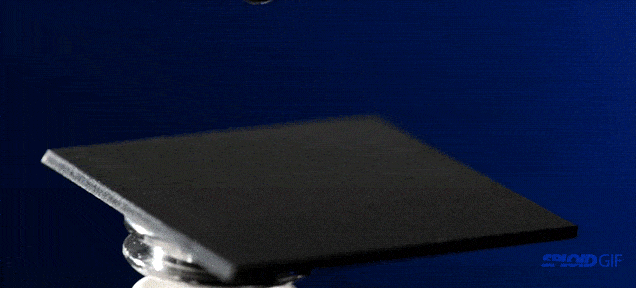A new generation of water-repellent products could be just ahead after researchers at University of Rochester demonstrated an amazing laser technique that etches tiny micro and nano grooves into a metal surface making it super-hydrophobic. As you can notice, the surface becomes so strongly repelled to water than the water molecules literally bounce off until they exit the surface altogether. We’ve seen such demonstrations before, but previous attempts relied on chemical coatings. Because the nano geometrical pattern is etched in the metal, it does not wear off.
Bouncy water molecules

Credit: University of Rochester // GIF via Sploid
“The material is so strongly water-repellent, the water actually gets bounced off. Then it lands on the surface again, gets bounced off again, and then it will just roll off from the surface,” said Rochester’s Chunlei Guo , professor of optics.
Previously, Guo and colleagues had used a similar laser-patterning technique that turned metals black. Building-up on this previous research, the team investigated what kind of properties metals would gain if certain intricate patterns of micro- and nanoscale structures were etched with high-power lasers.
Metal surfaces etched this way could be built in aircraft fuselage to reduce drag or built-in the next generation Teflon cookery. Teflon is also hydrophobic, but the difference is that to make water to roll-off a Teflon coated material, you need to tilt the surface to nearly a 70-degree angle before the water begins to slide off. You can make water roll off Guo’s metals by tilting them less than five degrees.

Credit: University of Rochester // GIF via Sploid
Of more practical worth would be implementing it in developing countries to store more water and build more hygienic latrines.
“In these regions, collecting rain water is vital and using super-hydrophobic materials could increase the efficiency without the need to use large funnels with high-pitched angles to prevent water from sticking to the surface,” says Guo. “A second application could be creating latrines that are cleaner and healthier to use.”
The researchers claim because there’s no chemical coating, the hydrophobic layer won’t rob off. But what about dust and other impurities gathering in the tiny etched grooves? According to the team, this isn’t a problem. The surface also collects dust particles and takes them along for the ride. In tests, ordinary dust from a vacuum cleaner was applied to the surface; with only three drops of water, half of the dust particles were removed. It’s still not certain how expensive hydrophobic metal surfaces would be. Nevertheless, it’s a pretty exciting project.
Findings appeared in the Journal of Applied Physics.









